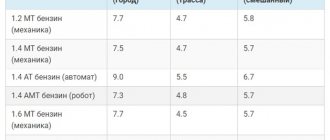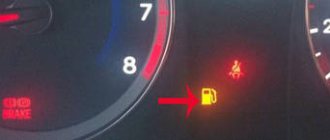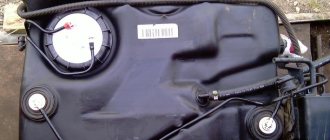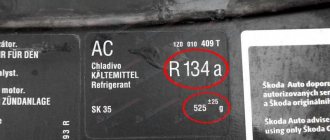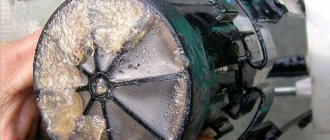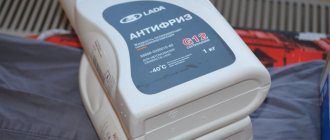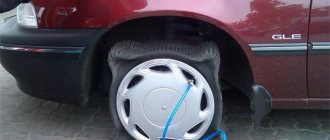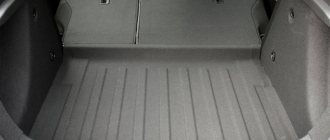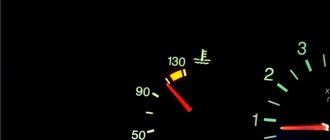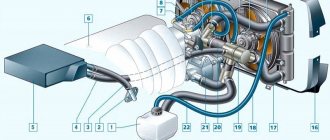Specifications 2114
Before we look at the main question - how much volume the VAZ 2114 tank holds, let’s look at the main technical characteristics of this car.
Its engine parameters are as follows:
- working volume - 1499 cm3;
- total power - 77 hp;
- maximum rotation speed - 5200 min-1;
- maximum torque - 116 N/m.
In turn, the main operating parameters of the VAZ 2114 car look like:
- acceleration time from 0 to 100 km/h - 14 s;
- maximum possible speed - 157 km/h;
- fuel consumption in urban conditions (per 100 km) - 9.9 l;
- fuel consumption on a suburban highway (per 100 km) - 6.2 l;
- fuel consumption when traveling in mixed conditions (per 100 km) - 7.5 liters.
Now consider the main weight and dimensions of the car:
- total length - 4122 mm;
- full width - 1650 mm;
- height - 1422 mm;
- ground clearance - 165 mm;
- wheelbase size - 2460 mm;
- front track - 1400 mm;
- rear track - 1370 mm;
- weight (curb) - 985 kg;
- weight (total) - 1410 kg;
- fuel tank volume (full) - 43 l.
As you can see from the table above, the gas tank on the VAZ 2114 holds exactly 43 liters. Is this really so? Let’s look at it below.
Options
Now let's talk about the main parameters of the VAZ 2114 model.
Let's be honest that the fourteenth was lucky due to the manufacturer's policy. The fact is that the first-born in the series was the VAZ 2115 model, which turned out to be the very first pancake lumpy.
Based on the mistakes made, developed for the fifteenth innovation and using the time-tested features of the nine, it was possible to create a complete and one of the most successful cars in the history of AvtoVAZ - VAZ 2114.
| Options | Description |
| Dimensions | The fourteenth model is a five-door hatchback with 5 seats and a spacious trunk of 330 m3. Dimensions of the car are 4122 by 1650 by 1402 millimeters (length, width and height). Weight is 970 kilograms and load capacity is 425 kilograms |
| Suspension | MacPherson struts are installed at the front, and trailing arms or coil springs at the rear. The wheelbase has 2460 mm, the front track is 1400 mm, the rear track is 1370 mm. The car is front-wheel drive with disc brakes at the front and drum brakes at the rear. At an average speed of 80 km/h, the braking distance in the presence of passengers is 40 meters. Ground clearance, that is, ground clearance, is 160 millimeters. |
| Salon | There are electric windows on the front doors, a heated rear window, an electric fan, heated front seats, electric locks, an on-board computer, high-quality finishing materials, and headrests on the rear sofa. At one time, the interior was characterized by a decent noise level, which at a speed of 100 kilometers per hour was only 74 decibels. Today, interiors have become much better, but for its age this is a breakthrough in the domestic automotive industry |
| Engine | What engines are installed on this model? Initially, the car came out with a 1.5-liter 8-valve engine. In 2007, the model switched to a 1.6-liter engine with 16 valves. Power was increased only in 2009 - from 77 initial horsepower to 89 hp. The gearbox is five-speed, and it has been improved. In 2010, the VAZ 2114 received an engine from Priora with a capacity of 98 horsepower and this was the last significant modification of the engines for the model. As for fuel consumption, it is 7 liters per 100 kilometers on the highway and approximately 8-9 liters per 100 kilometers in the city |
How good this car is in terms of technical characteristics is up to you to judge. Everyone has their own idea of a good car. We tried to tell in detail what the VAZ 2114 is.
Engine compartment
Many believe that the time of the fourteenth model is already behind us, and its successor in the person of Priora clearly proves this. But is this really so? If we compare these two models, will the Priora really be able to surpass its predecessor? A large number of experts will objectively prove that no.
Yes, Priora is a more modern, improved car. But is it enough? We think the domestic auto industry has room for improvement.
Heir to the fourteenth
In the meantime, the fourteenth demonstrates that it is not going to leave its leading position anywhere and is not ready for real successors. The time has not yet come.
Loading …
Actual tank volume on the 14th model
As mentioned, the manufacturer claims that the volume of the 2114 tank is 43 liters (in some cases you can find a figure of 42.5 liters). And this figure is indeed very close to reality.
At the same time, it is worth considering a number of facts that can significantly affect capacity:
- Errors in the manufacture of the tank.
- Time of year and temperature.
- Fuel system volume.
The first of these factors is usually insignificant. But, as practice shows, sometimes the difference in the volumes of two identical tanks can reach (as a result of low production accuracy) 2 liters. Thus, on some machines the total volume can reach 45 liters (which is extremely rare).
This should also include the difference in weather conditions. In cold weather, the fuel contracts, and in warm weather, it expands. This factor also affects how many liters the tank on a VAZ 2114 can hold (if we take into account the full volume of gasoline that can fit in hot summers and winter frosts, the difference can reach 1.5 liters).
Well, finally, you should remember that the fuel system itself also holds a certain amount of fuel. On average, when the tank is completely empty, up to 2 liters of gasoline can remain in it. As a result of this number of features, the amount of fuel contained in the tank may differ from that declared by the manufacturer, either more or less.
If at a gas station you managed to fill 50 liters of fuel into an almost empty tank, then this can become a good reason to complain about the accuracy of the filling device and the operation of the station itself. Such a large difference in volumes cannot be attributed to any of the above errors.
It is also worth noting that if the vehicle is operated incorrectly and refueled with low-quality fuel, sediment can accumulate at the bottom of the tank, which over time can (albeit insignificantly) reduce its volume. In order to avoid such a situation, the tank should be inspected every few years.
If the warning light on the panel lights up, it means you can fill the tank with up to 35 liters of fuel without fear of it overflowing.
Design
All modifications of the engine installed on the VAZ 2114 have a block cast from cast iron and a fuel injection system. Despite the design solutions used to improve dynamic and environmental performance, the design of the VAZ 2114 engine has retained its simplicity and reasonable maintenance cost.
Operation and resource availability
An oil change should be done every 9-11 thousand km.
Regardless of the modification, 3.2 liters will be required to change the oil. Recommended viscosity: 5W-30, 10W-40, 5W-40, 15W-40. According to the manufacturer, the engine life is 150 thousand km. (200 thousand km for Priora motor). Practice has shown that with proper maintenance, the engine can cover up to 250 thousand km.
Failure to comply with maintenance standards and improper tuning of the VAZ 2114 engine significantly reduces its service life.
Features and Disadvantages
1.5l:
- after a timing belt breaks, the valves remain unharmed;
- Regular adjustment of valve clearances is required;
- wear of cooling system components;
- oil leaks from under the valve cover;
- oil leakage from under the ignition distributor and fuel pump;
- poor fastening of the exhaust manifold (solved by replacing steel nuts with brass ones);
- unreliability of early injection systems.
1.6l:
- A broken timing belt does not deform the valve;
- the need for periodic valve adjustment;
- increased noise and vibration load.
16V 1.6i l (124):
- Thanks to the holes on the pistons, even with moderate sports shafts, if the timing belt breaks, the valves do not bend;
- Every 15 thousand km you need to tighten the timing belt.
16V 1.6i l (126):
a broken timing belt leads to bending of the valves (the problem can be solved by installing plug-free pistons.
Popular faults
Due to the imperfect quality of the unit and the large number of low-quality spare parts, the motor and attachments require increased attention.
Main problems and possible causes:
- Unstable idling of the VAZ 2114, the engine stalls after starting. Cause – Coking of the idle speed controller (IAC), throttle position sensor, vacuum seal “drizzle”, unreliable signals from the mass air flow sensor;
- Starting has deteriorated, the engine is running rough - the reason may be: incorrect valve adjustment, lack of compression in one of the cylinders (the valve may have burned out), wear of the valve springs, air leaks (check the connections of the hoses and pipes going after the mass air flow sensor and to the vacuum valve, valve hose purging of the absorber, tight fit of the injectors to the cylinder head), malfunction of the ignition module, spark plugs do not produce a spark, inoperability of high-voltage wires, incorrect valve timing (the timing belt may have slipped a few teeth);
- The VAZ 2114 engine has lost throttle response and does not pull. The breakdown is possible due to a malfunction of the ignition module (symptoms appear when the engine is warm), a clogged catalyst, the fuel pump does not create the required pressure, a dirty air filter, air leaks, carbon deposits on the spark plugs, lack of compression;
- Extraneous knocking, noise and vibration of the VAZ 2114 engine. Breakdown may occur because valve clearances need adjustment, sagging valve springs, sagging seats, wear of the main bearings of the crankshaft or connecting rod bearings (it is possible that the pistons themselves are knocking), hydraulic compensators, wear of the engine mounts (pillows);
- Does not show the engine temperature of the VAZ 2114. Occurs due to a malfunction of the coolant temperature sensor (the sensor screwed into the cylinder head is responsible for the readings on the instrument panel), open circuit, oxidation of contacts, a malfunction in the indicator on the dashboard;
- The engine is heating up. Thermostat failure (liquid circulates only in the engine cooling jacket). When buying a thermostat, look in the instructions for what engine operating temperature it is designed for (for the engines in question this is 95-103 degrees); Damage to the water pump impeller, malfunction of the fan switch sensor, or the fan itself does not work.
Consumption and travel distance
If we take into account the volume of the VAZ 2114 tank and the data on gasoline consumption (given in the table above), we can draw the following conclusions about the possible travel range.
When driving at a constant speed of 90 km/h, the maximum range can be almost 700 km without additional refueling.
When traveling in the so-called “mixed” city/highway mode, consumption will increase, which means the range will decrease (up to 640 km).
And when traveling only in city mode (taking into account standing in traffic jams and a large proportion of driving in low gears), fuel consumption will be maximum - almost 10 l/100 km. It is also worth considering that these figures are for new cars. For used cars they will be slightly higher.
Installing rear spacers
Fuel tank volume VAZ 21213
Installation of spacers under the rear shock absorbers is carried out according to the following scheme:
- Unscrew the fasteners of the lower part of the shock absorber.
By carrying out such a simple operation, you can significantly increase the vehicle's ground clearance in just a couple of hours compared to the factory version.
Before installing spacers on the VAZ 2114, it is worth remembering that an increase in ground clearance will lead to a change in three important parameters at once: the direction of the headlight beams; brake pressure regulator position; the angle of inclination of the front wheel axis. Considering that the last parameter affects the stability and controllability of the car on the road, after changing the clearance value, it is recommended to visit a car service center to set it up.
It should also be noted that after the changes have been made, the car should have the following toe-in/camber angles (with a load of 4 adults in the cabin and 40 kg of payload in the trunk):
- camber - 0°±30';
- toe - 0°00'±10' (0±1 mm);
- castor (rotation axis angle) - 1°30'±30'.
Without load, these same values must be within the following limits:
- camber — 0°30'±30';
- toe - 0°15'±10' (1.5±1 mm);
- castor - 0°20'±30'.
If the specified parameters go beyond the above acceptable limits, then you cannot operate the car - you should correct them yourself or at a service station.
Place 21093 in the AvtoVAZ model line
The prototype for the VAZ 21093 was the front-wheel drive hatchback VAZ 2109 “Sputnik”, with a 1.3 liter carburetor engine, produced in Togliatti since 1987. Its engine power was 64 horsepower. Externally, the 21093 Samara, which appeared in 1990, was not much different from the 2109. Dimensions, design, design - everything was almost like the nine. The main differences were hidden under the hood.
Modification 21093 received a new engine. The designers of the Volzhsky Automobile Plant increased the cylinder diameter from 78 to 82 mm with the previous piston stroke of 71 mm. This resulted in an increase in the working volume from 1288 cubic cm to 1499. The car's power increased, its performance characteristics improved (speed and acceleration dynamics), and fuel consumption decreased slightly. In general, the VAZ 21093 car has acquired noticeable liveliness.
The main mistakes made when tuning
Many people try to add power to the engine, but at the same time make typical mistakes. The leading ones among them are:
- installation of cutters in garage conditions (this work requires high precision);
- use of unnecessary and expensive spare parts;
- lack of suitable firmware for a sports camshaft or other elements.
Before buying expensive spare parts, you should pay attention to the recommendations of the specialists. They created a list of useless components:
- A receiver with an increased volume is good only at medium and high speeds, but for work in the range from 1000 to 2500 rpm, a standard spare part is more preferable.
- A zero filter, called a “chandelier,” is a fairly useful addition, but you will have to constantly clean it with special chemical compounds. This will increase the cost of maintaining the car.
- A throttle valve of increased diameter does not increase power too much, since the engine always has enough air.
There are ways to increase power that don't require a lot of investment or technical precision. Let's give examples of such tuning.
Body and interior of VAZ 21093
Over the years of production of modification 21093, some changes have occurred in the design while maintaining the same body dimensions. The body of the ninety-third is a five-door hatchback, its front part and radiator have been updated, and a short wing has appeared. The overall and internal dimensions of models 2109 and 21093 are the same down to the millimeter. The interior of car 21093 is five-seater, but it is difficult for three large men to fit in the back. The rear row of seats folds down, almost doubling the trunk volume (from 330 liters to 640 liters).
Main dimensions of the Lada 21093 car.
The luxury package had an improved dashboard with a tachometer and an on-board computer, and it was possible to install electric windows and an anti-theft system. Several options were offered for the upholstery and seats: from the most unassuming gray textiles to higher quality colored materials. The interior of the ninety-third was comfortable and practical both for daily trips to work and for relatively long trips with children.
How much does an empty gas tank from a VAZ 2114-2115 weigh? In kilograms. Can I take it off alone?
BODY Body type Sedan Number of doors 4 Number of seats 5 Length 4330 mm Width 1970 mm Height 1402 mm Wheelbase 2460 mm Front track 1400 mm Rear track 1370 mm Ground clearance 170 mm Maximum trunk volume 427 l ENGINE Engine location Front, transverse Engine capacity 1596 cm3 Power 81 l. With.
At rpm 5200 Torque 120/2700 n*m Power system Distributed injection Presence of turbocharging - Gas distribution mechanism - Cylinder arrangement In-line Number of cylinders 4 Number of valves per cylinder 2 Fuel AI-95 TRANSMISSION Drive Front Number of gears (mechanical transmission) 5 SUSPENSION Type front suspension Independent McPherson type Rear suspension type Trailing arm BRAKE SYSTEM Front brakes Disc Rear brakes Drum PERFORMANCE INDICATORS Maximum speed 158 km/h Acceleration time (0-100 km/h) 13.2 s Fuel consumption on the highway 7.6 l/100 km Fuel tank capacity 43 l Vehicle curb weight 985 kg Tire size 165/70 R13; 175/70 R13
Like all VAZs - 43 liters. to capacity!
93 engine options
There are two engine options for the 21093:
- carburetor VAZ 21083;
- injection VAZ 2111.
Both engines are in-line, four-cylinder, eight-valve and have a displacement of 1499 cm3. The motors are located transversely at the front. Their cylinder diameter and piston stroke are the same, and the compression ratio is 9.9. The engines consume gasoline: carburetor - AI-93, injection - AI-95. The fuel tank capacity is the same - 43 liters.
The VAZ 21083 engine on the VAZ 21093 carburetor model develops maximum power of 70 horsepower at 5600 rpm, and torque is 104 Nm at 3400 rpm. The maximum speed is 154 km/h, the engine accelerates the car to 100 km/h in 13.4 s. Fuel consumption of the VAZ 21093 per 100 km in the city is 8 liters, outside the city - 5.7 liters, in the combined cycle - 6.8 liters. The curb weight is 915 kg.
In 1994, an injector version of the VAZ 21093 was released, designated VAZ 21093i. The technical characteristics of the VAZ 21093i have changed for the better. Engine power increased to 78 horsepower at 5400 rpm, torque was 116 Nm at 3000 rpm. Acceleration time to 100 km decreased to 13 s.
Engines of different sizes and power can be installed under the hood of a hatchback. The first models were equipped with a four-cylinder, eight-valve engine, the volume of which was 1100 cc. cm. In subsequent models, this figure increased by 1300 cc. cm, and later reached 1500. In the 90s, a model with an injection engine was also released.
Tuning an injector with 8 valves
To increase power from 77 to 96 horsepower of the very first engine of the VAZ-2111 model, you need to do:
- boring valve seats along the inner diameter;
- boring the channel necks for installing duralumin plates and loosening the springs by 1.5 millimeters;
- replacing standard valves with lightweight ones;
- recessing of guide bushings from special brass;
- installation of a split timing gear;
- use of imported valve cotters;
- installation of a narrow-phase shaft.
The tuning shaft has an inlet of 70 degrees and an outlet of 66. Its opening angles are 250 and 246 degrees, respectively. After completing the work, it is necessary to install the engineering firmware and carefully configure the motor parameters. Only in this case, after all sensors are turned on, the engine will start working normally.
It is better to use a split gear on non-plug-in motors. For installation, it is necessary to carry out the work almost the same as when replacing the timing belt, that is, apply marks, disassemble the mechanism, align the crankshaft
After installing the new gear, pay attention to the 4th cylinder. If the valves in it are not open as much as possible, in which case you will need to loosen the outer screws and adjust the camshaft, after which you need to tighten the fasteners
Transmission and chassis of the VAZ 21093
The transmission on the VAZ 21093 is structurally made of one unit, including a clutch and a manual gearbox (MT). The gearbox is combined with a differential, the clutch is single-plate. The clutch housing is connected to the flywheel with bolts. To ensure contact with the pressure plate, six elastic plates are used.
The car's wheel drive includes two constant velocity joints (CV joints): a rod shaft on the left and a tubular shaft on the right. The front suspension of the car is independent, hydraulic shock absorbers, cylindrical springs. The rear suspension is torsion bar, independent, with a trailing arm design.
The braking system on the 21093 uses front disc brakes and rear drum brakes. There is a diagonal interaction of contours. One circuit includes the right front and left rear wheels, the other - the remaining two. The hydraulic drive of the system includes a vacuum booster and a pressure regulator for the rear brakes.
The VAZ 2109 was first produced back in 1988. The five-door design allowed this car to be used as a successful family commercial vehicle. At the same time, the car is often used for transporting small-sized cargo, as it is equipped with a fairly simple luggage compartment.
Due to the fact that the VAZ 2109 is a very practical and easy-to-maintain car, it is popular among young people. Due to its distinctive sporty look and great lightness, it is ideal for tuning enthusiasts. Modernization in this area includes not only a transformation of the appearance, but also engine tuning. Sports riding enthusiasts change the following:
- basic bumpers - for stylish sports body kits,
- install powerful, direct-flow exhaust pipes,
- standard air filters - for sports ones.
The car gains improved aerodynamic properties and increased power. But tuning fans don’t stop there and upgrade the engine in a sporty way. Today you can often find VAZ 2109 with turbine engines, which take part in street racing along with foreign cars.
Another way to tune a VAZ 2109 is to replace the car’s dashboard. In configuration, it is similar to panels of such brands as BMW 3, Mazda 626, Opel Vectra. They are so suitable in configuration that they do not undergo any modifications before installation in the “nine”. Anyone who plans to do this will replace the dashboard of any problems.
The VAZ 2109, the price of which is affordable for everyone, has proven itself well on the Russian market. And despite the fact that the production of the “nine” has completely stopped since 2011, it is still in high demand. To make the car more interesting, you will have to spend money, but after tuning it will be difficult to recognize it as a VAZ 2109.
The production of the VAZ-2109 car began in 1988 by the Volzhsky Automobile Plant. Its predecessor was the VAZ-2108, compared to which the body of the “nine” became more elongated, and there were two more doors (five). Thanks to the increased number of doors, many people used it as a family car.
The interior of the VAZ-2109 is strictly practical and claims to be comfortable. In the first case, we should note the laconic “low” dashboard, which is somehow a little convenient. The front seats have headrests. In the second case, it is worth noting the informative “high” dashboard, thanks to which you can clearly monitor the status of its on-board systems.
And thanks to the improved interior (door upholstery with rates, fabric seat upholstery), the car can acquire a more prestigious look. If you fold the rear seats, this car takes on a cargo-passenger appearance, like a station wagon.
The last cosmetic upgrade for this car was made in 1997. Since 2001, they began to produce them with injection engines. Maintenance of this car is almost as economical as for other models of the Volzhsky Automobile Plant.
How many liters of gasoline are in the tank of a VAZ 2114
What is the volume of the fuel tank of the VAZ 2114?
- Is it normal or not when the revs drop when the lights are turned on? – 4 answers
- Overflow or is this normal, VAZ 2115? – 3 answers
- The fuel pump hums before turning off on a VAZ 2109 - 3 answers
- VAZ 2115 troits, does not move - 3 answers
- Why does the VAZ 2115 take a long time to start after a short stop? – 3 answers
The nominal volume of the fuel tank of the VAZ 2114 is 42.5 liters .
You can top it up, as they say, under the cap. Those. When the filling nozzle cuts off, you can press the regulators and carefully, in small portions, add a few more liters. But you need to be careful, especially in the summer, when gasoline expands from the heat.
Considering that gasoline consumption per 100 km (at a speed of 90 km/h) is approximately 5.7 liters, then on a full tank you can travel more than 700 km. without refueling.
But if you drive at 120 km/h, the consumption increases by 7.8 liters, and in urban conditions even more - 8.9. Accordingly, the distance traveled will be shorter.
Post edited by TEMbI4: 10/06/2010 — 21:28
- Megatheronosaurus
- Group: Disabled
- Posts: 8,690
Post edited by kkvvnn: 10/06/2010 — 17:48
tell me how many liters the tank is 2114. The volume of the tank is VAZ 2114.
Similar articles
20 comments on “Tank volume of VAZ 2114. How many liters of tank 2114”
43, but I poured it into a dry tank up to my throat, it came out around 48 liters
43 liters according to the book.
someone has a rubber tank!
43 but you can fill in 47
please tell me VAZ 21053 there was a problem with the 4th cylinder, either the roofing felt valve burned out or something else, in general it was shooting and the car was barely moving, the problem was fixed, but now the consumption has increased threefold, that is, about 25 liters per hundred, I don’t know where to dig, maybe someone can give advice ?? Is such a flow rate possible due to the valves? Or is the carburetor at fault?
And that everything is possible, I drove a Kamaz there, according to the documents, the tank is 200 liters and it almost fits on a dry tank of 230, but if you think about it, it’s all 240
So, if you pour it all the way down, everything is possible))) I’ve also had gasoline escape through the neck)))
Well, in general, you can fill the engine with oil up to the top. only if you start - 3.14 for all seals. It is better not to exceed your passport data. You also take into account physics - when heated, expansion occurs, and where does gasoline go if everything is filled under the gas tank cap?
Misha, that’s why there is a plastic box over the neck that prevents vacuum from forming. It’s on the classics that the car starts to run worse, the later ones have already thought about it.
Aidar, well, according to this principle, antifreeze can be poured under the lid, there is also a valve for releasing gases
Misha, is there a Min or Max mark and a dipstick in the tank?
Aidar, tidying up for whom? If anyone didn’t know, the rightmost sensor shows the level there. and every literate person will inquire and know the volume of their gas tank, which can be easily found on the Internet if there is no service book
Misha, only the sensor shows full when the tank is full, but the fact that there is a tube going up to the neck, where a couple of liters can still fit, is not there. And no, not everyone. This sensor also beeps, at least by a couple of liters.
Aidar, in general it is clear that there are problems with physics, further dispute is pointless
What is better antifreeze or antifreeze for VAZ
Beginning car owners of the domestic automobile industry, learning the basics of car ownership, often ask various questions about servicing and repairing VAZs.
One of the most frequently asked questions regarding the cooling system: which is better - Antifreeze or antifreeze for VAZ? The question is quite interesting and is asked often, especially from owners who purchased a car, but were unable to get a clear answer from the former owner as to what was poured into the cooling system.
And before the winter period, when car preparation is required, this question comes up and makes you think. Let's try to figure it out.
How many liters of gasoline are in the tank of a VAZ 2114
What is the volume of the fuel tank of the VAZ 2114?
- Is it normal or not when the revs drop when the lights are turned on? – 4 answers
- Overflow or is this normal, VAZ 2115? – 3 answers
- The fuel pump hums before turning off on a VAZ 2109 - 3 answers
- VAZ 2115 troits, does not move - 3 answers
- Why does the VAZ 2115 take a long time to start after a short stop? – 3 answers
The nominal volume of the fuel tank of the VAZ 2114 is 42.5 liters .
You can top it up, as they say, under the cap. Those. When the filling nozzle cuts off, you can press the regulators and carefully, in small portions, add a few more liters. But you need to be careful, especially in the summer, when gasoline expands from the heat.
Considering that gasoline consumption per 100 km (at a speed of 90 km/h) is approximately 5.7 liters, then on a full tank you can travel more than 700 km. without refueling.
But if you drive at 120 km/h, the consumption increases by 7.8 liters, and in urban conditions even more - 8.9. Accordingly, the distance traveled will be shorter.
Post edited by TEMbI4: 10/06/2010 – 21:28
- Megatheronosaurus
- Group: Disabled
- Posts: 8,690
Post edited by kkvvnn: 10/06/2010 – 17:48
tell me how many liters the tank is 2114. The volume of the tank is VAZ 2114.
Similar articles
20 comments on “Tank volume of VAZ 2114. How many liters of tank 2114”
43, but I poured it into a dry tank up to my throat, it came out around 48 liters
43 liters according to the book.
someone has a rubber tank!
43 but you can fill in 47
please tell me VAZ 21053 there was a problem with the 4th cylinder, either the roofing felt valve burned out or something else, in general it was shooting and the car was barely moving, the problem was fixed, but now the consumption has increased threefold, that is, about 25 liters per hundred, I don’t know where to dig, maybe someone can give advice ?? Is such a flow rate possible due to the valves? Or is the carburetor at fault?
And that everything is possible, I drove a Kamaz there, according to the documents, the tank is 200 liters and it almost fits on a dry tank of 230, but if you think about it, it’s all 240
So, if you pour it all the way down, everything is possible))) I’ve also had gasoline escape through the neck)))
Well, in general, you can fill the engine with oil up to the top. only if you start - 3.14 for all seals. It is better not to exceed your passport data. You also take into account physics - when heated, expansion occurs, and where does gasoline go if everything is filled under the gas tank cap?
Misha, that’s why there is a plastic box over the neck that prevents vacuum from forming. It’s on the classics that the car starts to run worse, the later ones have already thought about it.
Aidar, well, according to this principle, antifreeze can be poured under the lid, there is also a valve for releasing gases
Misha, is there a Min or Max mark and a dipstick in the tank?
Aidar, tidying up for whom? If anyone didn’t know, the rightmost sensor shows the level there. and every literate person will inquire and know the volume of their gas tank, which can be easily found on the Internet if there is no service book
tank volume, how much gasoline fits in the fuel tank?
The volume of the fuel tank in the car primarily determines the number of kilometers that can be driven without refueling. You need to know this if you are going on a long trip or spend a lot of time moving around the city. A car enthusiast needs to be able to plan his route in such a way as to be able to visit a gas station in a timely manner. Let's tell you what the volume of the tank is in a VAZ-2115 car.
Tank volume and why it changes
According to the technical documentation for the VAZ-2115, this car has a fuel tank with a nominal volume of 43 liters. However, its design feature is a long neck, into which you can pour another 2 to 5 liters. There is a fierce debate among car enthusiasts over how many liters can actually be placed in the tank of a standard “tag”. Many even believe that in cold weather a larger amount of fuel can be placed in the container than on a hot summer day.
In fact, the reason for the change in the holding volume of fuel is the deformation or stretching of the tank. If the surface of this spare car part has many dents, then its capacity will decrease. Over time, some car enthusiasts begin to notice that more gasoline is placed in the tank for refueling the car; this is due to the swelling of the tank.
It is unknown what the displacement will be in the latter case, but in practice, service station specialists have encountered tanks with a capacity of 50 liters (excluding the neck).
Problems of the VAZ-2115 fuel tank
The gasoline tank on the VAZ-2115, as in any other car model, is made of metal. This material tends to stretch and compress under the influence of external forces. This is far from the only problem with fuel capacity in this car. Most often, owners of this vehicle encounter the following problems:
- fuel leakage;
- incorrect operation of the sensor;
- design flaws.
The first and last faults are often related. The fact is that in carburetor models a separator is used. This device is necessary to collect gasoline vapors and condense them. After the vapor turns into liquid, it is drained back into the tank. Most VAZ-2115s are equipped with a plastic separator, which over time becomes covered with cracks, melts and becomes deformed. In such cases, it is necessary to replace it with a metal model, which is more resistant to external influences. The injector does not have such an element in its design.
Incorrect display of the fuel level in the tank can be caused by two reasons:
- If, after starting the engine, the instrument on the panel shows different values, then you need to look for a problem in the handbrake area. There is a ground wire running through it, the fastening of which may become loose when the vehicle is used. It is enough to tighten two bolts for the problem to disappear.
- After repairs, the gasoline consumption control lamp may come on prematurely. This is due to the fact that the float sensor located in the fuel container is triggered ahead of time. At the moment when the float drops to a certain level, the contacts close. It is enough to bend the limit switch slightly so that the closure occurs a little later.
Remember that all work on the fuel system must be carried out in compliance with safety rules.
How often should you change the engine oil: opinions of car owners
- It all depends on the lubricant Tank volume for VAZ 21099
“The brand name is of great importance. Domestic cheap Lukoil is replaced every 5-6 thousand. More expensive oils have many high-quality additives: detergents, anti-aging, anti-foaming, etc. During the first tens of kilometers, the engine is cleaned under the influence of high temperature, the detergent components evaporate, and restorative additives come into play.Such oil should also not be “driven” for more than 10 thousand. The motor will constantly be washed out and, I think, will require “capitalization” faster because the layer formed by the reducing components on the metal surface will constantly be destroyed. I believe that the mileage between replacements should not exceed 10–12 thousand kilometers, and it is advisable to do maintenance after the winter season; in winter, accumulated condensate can negatively affect the properties of the oil.”
- Changing the oil is like brushing your teeth
“There is an opinion (and whether you believe it or not is up to you) that lubricants now are completely different from what they used to be, even from famous brands, and that they are all poured from the same barrel underground somewhere in Poland or Samara. Therefore, you need to change the oil and... the car more often))). Here everyone chooses their own decision. Considering today's fuel prices, replacing lubricant is not that expensive. To please your engine - is this unpleasant for a good owner? Changing your oil is like taking care of your teeth. We clean in the morning and sometimes before bed. More often does not mean better, as we wear away the enamel more; but even less often - it can lead to caries. Setting priorities is up to you personally.” - Looking for a middle ground
“How often to change the oil largely depends on how you use the car. Replacement every 5-7 thousand km is paranoia and a waste of money. The opposite extreme is to drive 500–1000 km every day and forget to change it altogether when the mileage is already under twenty. But it’s better every 10,000 km - this is a good reinsurance for our difficult Russian conditions. For example, new Kia-Sportage models have a service-to-service mileage of 15,000 km. It turns out that 10–12 thousand is the golden mean. Any lubricant - Motul, Castrol, or even our LUKOIL or Lux - will withstand this period perfectly.” - The engine runs even when the odometer does not turn
“On most public pages and auto forums, entire threads of holiwars and battles arise regarding oil changes. Manufacturers often recommend changing it every 10,000 or 15,000 kilometers. The mindset of an ignorant consumer is to follow this recommendation, because otherwise we will lose the warranty. Being under warranty service, as many people believe, means “you came, left the key, and they silently did everything right for you.”However, anyone who has actually encountered dealers knows that the “officials” have a different vision of the guarantee. As an experienced master, I can say that often the lubricant practically loses its properties after 6-7 thousand. And don’t forget that Muscovites, for example, drive their car most of the time in traffic jams, the odometer doesn’t spin, and the engine idles.”
- In any case, it is better to rely on engine recommendations ahead of schedule. It’s better to focus on the standard requirements of automakers regarding intervals and timing of maintenance.”
How many liters are in the gas tank of the 2115?
BODY Body type Sedan Number of doors 4 Number of seats 5 Length 4330 mm Width 1970 mm Height 1402 mm Wheelbase 2460 mm Front track 1400 mm Rear track 1370 mm Ground clearance 170 mm Maximum trunk volume 427 l ENGINE Engine location Front, transverse Engine capacity 1596 cm3 Power 81 l. With. At rpm 5200 Torque 120/2700 n*m Power system Distributed injection Presence of turbocharging – Gas distribution mechanism – Cylinder arrangement In-line Number of cylinders 4 Number of valves per cylinder 2 Fuel AI-95 TRANSMISSION Drive Front Number of gears (mechanical transmission) 5 SUSPENSION Type front suspension Independent McPherson type Rear suspension type Trailing arm BRAKE SYSTEM Front brakes Disc Rear brakes Drum PERFORMANCE INDICATORS Maximum speed 158 km/h Acceleration time (0-100 km/h) 13.2 s Fuel consumption on the highway 7.6 l/100 km Fuel tank capacity 43 l Vehicle curb weight 985 kg Tire size 165/70 R13; 175/70 R13
Like all VAZs - 43 liters. to capacity!
according to passport 42_5
Today I looked at half the tank
